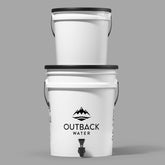Dehydration and Proper Hydration
How much water consumption is enough and how much is too much?
We all know our bodies are composed primarily of water - 60-65% for men and 55-60% for women. Therefore adequate water consumption is critical to maintain health and in our efforts to pursue active and productive lifestyles.
But what happens to our bodies when our water consumption gets out of balance - where we find ourselves not drinking enough and falling into a state of dehydration. Or what happens when, in some cases, we consume too much water and find ourselves suffering from hyponatremia.
Let us start with dehydration:
By definition dehydration is the process of losing or removing water or moisture. Dehydration occurs in the body when it uses or loses more fluid than it takes in. The result is that the body doesn’t contain enough water or fluids to carry out its normal functions. This excess loss of water can also cause a dangerous rise in blood sodium levels. Since dehydration is most often caused by excessive sweating, vomiting or diarrhea, water loss is usually accompanied by a deficiency of electrolytes.
There are varying degrees of dehydration and related symptoms - ranging from mild to severe. It may seem logical that if we are not involved in any form of strenuous activity we have little to worry about fluid loss and replenishment. But consider this: there are two main routes of body water loss; transpiration and breathing – and every day the average adult loses about 14 ounces of water by transpiration (perspiration through the skin) and another 14 ounces of water by exhaling (breathing) moist air (estimation for a dry climate). So, in 24 hours we can lose 28 ounces or 3 ½ 8 ounces glasses of water by simply doing nothing. If this water/fluid loss is not replaced we will find ourselves in a state of mild dehydration.
Although this volume of water loss may not have the same severe effect as someone who is engaged in a vigorous exercise program (especially in hot weather), or someone suffering from an illness (with intense diarrhea, vomiting, fever or excessive sweating), mild cases of dehydration can have symptoms such as headaches, general discomfort, loss of appetite, dry skin, decreases urine volume, confusion, unexplained tiredness and irritability and, of course, feeling thirsty. Typically, mild to moderate dehydration can be reversed by drinking more fluids. But some moderate cases will require a visit to the emergency to be given fluids intravenously. And severe cases, if left untreated, can cause seizures, brain damage, and can even be fatal.
To avoid dehydration you must simply be conscious of both your fluid loss and your fluid consumption in “normal times” and make sure your consumption increases enough to cover any increased fluid loss during hot weather, times of intense exercise or during an illness. Simply make sure you always drink enough water to replace what you lose.
This makes perfect sense. It’s about being sure that we’re properly hydrated and maintaining that balance. So, what happens if we ‘overbalance’ and consume too much water? Can that cause a health related problem. Can we become over-hydrated?
The answer is YES and the condition is called hyponatremia or “Water Intoxication”.
Hyponatremia is a condition where the sodium level in the blood is below normal. Sodium is an electrolyte that helps to regulate the amount of water that is in and around your cells. Your body requires sodium to balance fluids, control blood pressure and to allow the nerves and muscles to perform properly. The normal blood sodium level in the body is 135 – 145 milliequivalents/liter (mEg/L). When your blood sodium level drops below135 mEq/L, hyponatremia occurs.
Sodium is the primary positively charged ion in the environment outside of the cell and cannot freely cross from the interstitial space into the cell. Charged sodium ions can attract up to 25 water molecules around them thereby creating a large polar structure, this structure is too large to pass through the membrane of the cell. When the sodium level in your blood supply is too low, excess or extra water can enter your cells causing them to swell. This swelling of the cells can be dangerous especially if it occurs in the brain, as the brain has limited expansion ability due to the restriction of the skull, swelling of the brain cells causes a condition referred to as hyponatremic encephalopathy. This condition, if left untreated, can prove to be fatal.
There are several possible causes for a low sodium level in your blood supply ranging from drinking too much water to an underlying medical condition. Regardless of cause, excess water in the body is referred to as “watering down” - an effect which makes the amount of sodium seem low. When this happens you can become water intoxicated. A good example of water intoxication took place in 2007 when a woman consumed 2 gallons of water in a short period of time as part of a radio broadcast contest called “Hold Your Wee for a Wii” after drinking the water she developed “water intoxication”, experiencing symptoms of a headache, nausea and vomiting, which ultimately resulted in death.
So, as mentioned in our discussion about dehydration, regardless of your activity level drinking an adequate amount of water on a daily basis is important. Find balance and then replace what you lose. But we must also be mindful not to get too carried away. When it comes to staying hydrated the balance is important and “more is not always better”.
Water intoxication has symptoms similar to heat stroke. You may begin to feel tired and overall a bit lousy. The excess water in you your body can cause your temperature to rise and you may begin to feel nauseous you may experience diarrhea and vomiting. Another sign or indicator maybe an intense headache causing you to feel queasy.
How much is too much? The answer sounds like quite a lot of water. Studies have shown that 6 liters (2 gallons) of water consumed in a short period of time can have serious adverse affects to a 165 pound person. The best way to prevent water intoxication is to regulate how much water you drink. One way to measure your water intake is to drink until you no longer feel thirsty. Do not drink more than you sweat and check your urine when you go to the bathroom. If your urine is consistently dark, you are most likely dehydrated, if your urine is constantly clear you could be drinking too much, a light yellow color is ideal.
Overall, suffering from a case of “Water Intoxication” is somewhat rare, and something most of us never have to worry about. Most importantly if we follow a simple process of consistent and regular intake of water throughout the day that balances fluids lost, we can feel confident that we will not fall victim to either dehydration or hyponatremia.
- Choosing a selection results in a full page refresh.





